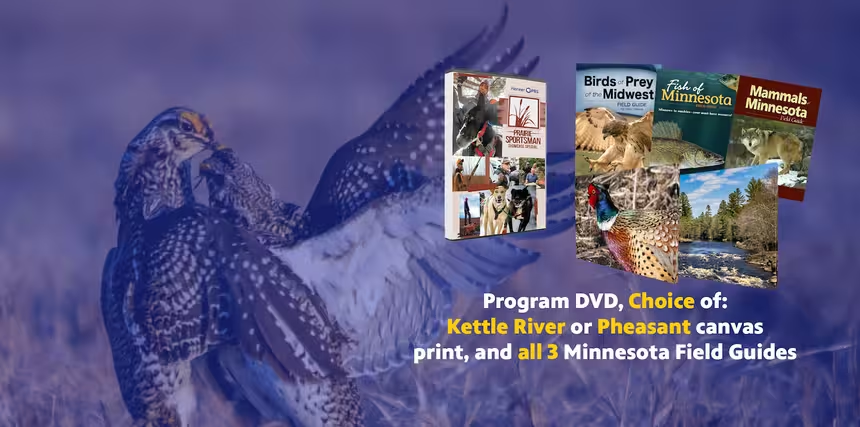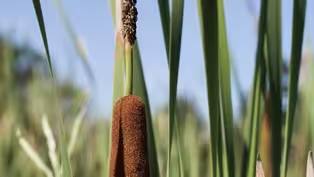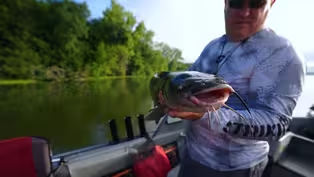Prairie Sportsman
Cattail Imposters
Clip: Season 16 Episode 2 | 8m 23sVideo has Closed Captions
Invasive hybrid cattails are removed to evaluate impacts on fish habitat.
Researchers remove invasive hybrid cattails from six test sites to evaluate the impacts on water quality and fish habitat. The hybrid cross between native broadleaf and non-native narrowleaf cattails can take over shoreline lake habitat.
Problems playing video? | Closed Captioning Feedback
Problems playing video? | Closed Captioning Feedback
Prairie Sportsman is a local public television program presented by Pioneer PBS
Production sponsorship is provided by funding from the Environment and Natural Resources Trust Fund, West Central Initiative, Shalom Hill Farm, and members of Pioneer PBS.
Prairie Sportsman
Cattail Imposters
Clip: Season 16 Episode 2 | 8m 23sVideo has Closed Captions
Researchers remove invasive hybrid cattails from six test sites to evaluate the impacts on water quality and fish habitat. The hybrid cross between native broadleaf and non-native narrowleaf cattails can take over shoreline lake habitat.
Problems playing video? | Closed Captioning Feedback
How to Watch Prairie Sportsman
Prairie Sportsman is available to stream on pbs.org and the free PBS App, available on iPhone, Apple TV, Android TV, Android smartphones, Amazon Fire TV, Amazon Fire Tablet, Roku, Samsung Smart TV, and Vizio.

Prairie Sportsman Premium Gifts
Do you love the great outdoors, hunting, fishing, hiking and conservation? Consider becoming a friend of Prairie Sportsman to support it and receive gifts with your contribution.Providing Support for PBS.org
Learn Moreabout PBS online sponsorship(light music) - So we have a native cattail in Minnesota, it's called the broadleaf cattail.
We also have a non native cattail called narrow leaf cattail that came from Europe, it's been in Minnesota since probably the '40's.
Wherever you have that narrow leaf invasive and the native, they always reproduce together, and that hybrid is what causes the problem.
(light music continues) When you have invasive broad leaf cattail, it causes negative impact to fish communities, negative impacts to water quality.
On most lakes, especially around metro, when you see a large fringe, a wide fringe of cattail, it's probably the hybrid.
Native cattail grows, really in more marshy areas, not out into the deep water.
Lotta times you'll see it in a ditch by the road, or in a wetland, you'll see it's interspersed with lots of other plants.
The native has a very much wider leaf, it also has a bigger fatter catkin.
This brown part is the catkin, that's the female flowering part of the plant, the top part is the male part of the plant.
It's a little bit past flower, but you'd shake this, and that's where the pollen comes from.
And you can see, there is a space here, a really visible space between the male and female part of the plant.
So if you were looking at a native cattail you would see hardly any space, they would be touching, almost touching.
The hybrid grows in both deeper and shallower water than either of its parents.
When water's low, cattail moves in, and then it keeps expanding and expanding.
It, suppresses native plants, you get this big monoculture of cattail that turns what was once water, into almost terrestrial area, and fish don't seem to like it as well, dissolved oxygen is much lower in the water column when you have cattail.
There are some lakes that are entirely ringed by cattail, and that's probably all hybrid cattail.
And we started to think about the fact that it's ubiquitous, it's everywhere, we're never going to eradicate it.
So how can we manage it at a small scale in a way that doesn't impact non target species?
Right, for example, if you spray it with herbicide, you would be negatively impacting amphibians and larval fishes.
So we started thinking about, mechanical removal.
Cutting cattail below the water to increase the area available for native plants, and perhaps increase habitat suitability for fishes.
The Minnesota Aquatic Invasive Species Research Center was interested in funding some work on hybrid cattail, so that's how it was funded, through MAISRC, and by the Environment and Natural Resources Trust Fund.
We, scouted a lot of lakes in our first summer, trying to find suitable sites on areas of public land, and DNR was really helpful with that.
So we came up with nine lakes that we studied.
- The initial cattail removal happened in the fall of '21.
After the first year of sampling it was contracted out to local company to do removal, which they did with mechanical harvesters, and also a lot of hand trimming with motorized weed trimmers.
When we're removing cattails, we're doing it underwater.
They have to be cut below the water in order to deprive the stems of oxygen so that they don't come back.
So here, we've got a couple inches of water basically, so you would need to go, basically all the way down to the root here, to get them to prevent them from growing back.
When we revisited our sites this year after they were initially cut in 2021, definitely we've noticed shifts in the vegetation community, we've got a lot of native aquatic species coming back and colonizing in the sites where cattails have been removed.
- From phase one we learned that there is, when you remove cattail, you see increases in dissolved oxygen in the water column.
And we do seem to be seeing differences in fish community, but we needed a little more monitoring data.
So that's what we're doing now, is looking a little bit more extensively at fishes, looking at how fishes are using these openings and cattail stands at different times of the year.
- We're doing minnow tra sampling and vegetation sampling at six lakes across Minnesota this summer.
There's been at least some regrowth of cattails at all of our sites.
So we have been going in with basically just a weed trimmer and removing what has sprun back up in the year since 2021.
Today we are out doing our minnow trap sampling at Big Marine Lake.
We set minnow traps earlier this week, and so every day we go out and check them to see what fish have wandered into our traps overnight.
We have minnow traps set in like a stand of native vegetation, set in a cattail stand, and also in our site where we've cut down the cattails.
We're looking to see just if there's differences in the fish community between those three different sites.
- We've learned that if you set them out for 10 days you collect probably all the species that are there.
So this is the third year of the project, so we have two years, a little bit of a break, and then this is phase two.
So we'll have either two or three summers going forward.
As we all know, years are really variable.
The first year of our study was a drought, the second year was a flood.
So, when you have a lot of variability, it's important to sample multiple times so you can get a sense of what's really going on, in spite of the climatic variability.
If we can remove cattail and let plants grow back with a permit, which of course you need to remove cattail, that can be beneficial.
So it's something that has the potential for Minnesotan's to do.
You can get an aquatic plant management permit from the DNR.
The permit currently is 15 feet from shoreline to open water.
They will come out and inspect, and let you know, yes or no, whether you're able to do that.
There are a number of commercial contractors who will come and remove it.
Some people do it on their own.
Our crew does it with kind of what I call the underwater weed whacker.
Some people just use a hand rake method.
You can't dig up the soil.
(light music continues) We're never gonna get rid of it, but we're trying to manage it.
Cutting cattail's only part of the story, we really wanna make sure that we're allowing native plants to grow back.
We move it outta the water.
It allows sunlight into the water column and down to the sediment.
Aquatic plant seeds are viable for many years in the sediment, so really, we found just opening up the space, and the sunlight to get to the sediment, native plants are coming back.
Things like bull rush, lily pads, all those different pond lily's, water celery's, potamogeton's, what you think of as, as I was a kid, seaweed.
Lakes are super important to Minnesota, we're the land of 10,000 lakes.
One of the things we really like to do on lakes is fish, and recreational fishing is of economic importance to Minnesota, and people, you know their grandkids come and wanna fish.
So, if we want healthy fish communities, healthy lake ecosystems, you wanna be able to swim, you need to make sure your vegetated near shore ecosystems are healthy.
(light music continues) (light music) - [Announcer] Stories about aquatic invasive species research are brought to you by the Aquatic Invasive Species Task Forces of Meeker, Yellow Medicine, Lac qui Parle Swift, and Big Stone Counties, and by, the Environment and Natural Resources Trust Fund.
We can stop aquatic hitchhikers from infesting more lakes and streams by cleaning up everything we pull out of the water.
It's a simple drill, clean in, clean out.
Before leaving a water access, clean your boat and water equipment.
Remove and dispose of all plants and aquatic species in the trash.
Drain water from your boat, ballast tanks, motor, live well, and bait container, remove drain plugs, and keep drain plugs out while transporting equipment, dispose of unwanted bait in the trash.
To keep live bait, drain the water and refill the bait container with bottled or tap water.
And if you've been in infested waters, also spray your boat with high pressure water, rinse with very hot water, dry for at least five days.
Stop the spread of AIS.
Preview: S16 Ep2 | 30s | Learn about successful catfish stocking and researchers study invasive hybrid cattails. (30s)
Video has Closed Captions
Clip: S16 Ep2 | 28m 2s | Learn the history surrounding channel catfish on the Sauk River chain of lakes. (28m 2s)
Video has Closed Captions
Clip: S16 Ep2 | 2m 17s | Nicole Zempel shows viewers how to identify wild catnip. (2m 17s)
Providing Support for PBS.org
Learn Moreabout PBS online sponsorship
- Science and Nature

Explore scientific discoveries on television's most acclaimed science documentary series.

- Science and Nature

Capturing the splendor of the natural world, from the African plains to the Antarctic ice.












Support for PBS provided by:
Prairie Sportsman is a local public television program presented by Pioneer PBS
Production sponsorship is provided by funding from the Environment and Natural Resources Trust Fund, West Central Initiative, Shalom Hill Farm, and members of Pioneer PBS.




